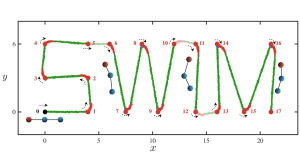
Researchers from the University of Hong Kong, New Jersey Institute of Technology, and Santa Clara University have successfully taught microrobots to swim through deep reinforcement learning, an incredible development in microswimming capability.
Artificial microswimmers capable of navigating the world like swimming microorganisms such as bacteria, provide promise for a wide range of biomedical applications. Currently, most artificial microswimmers can only perform simple movements with fixed locomotory postures.
The study, published in the Journal of Communications Physics, stated that microswimmers could learn and adapt to dynamic conditions with the help of AI. Microswimmers like humans, need feedback and reinforcement learning to stay afloat and move in different directions under dynamic conditions.
‘Being able to swim at the micro-scale by itself is a challenging task,’ said On Shun Pak, Associate Professor at Santa Clara University. ‘When you want a microswimmer to perform more sophisticated maneuvers, the design of their locomotory gaits can quickly become intractable.’
Through the integration of reinforcement learning and artificial neural networks, the team had success in teaching a microswimmer to navigate and swim in any direction. When the swimmer moves in certain directions, it gets feedback on how good that action is. Subsequently, the swimmer learns how to swim based on its previous experiences interacting with the environment.
‘Similar to a human learning how to swim, the microswimmer learns how to move its “body parts”— in this case, three microparticles and extensible links— to self-propel and turn,’ said Alan Tsang, Assistant Professor at the University of Hong Kong. ‘It does so without relying on human knowledge but only on machine learning algorithm.’
To demonstrate the swimmer’s powerful ability, the researchers illustrated that it could follow a complicated path without explicit programming. They also showed the swimmer’s robust performance in navigating under the disturbance of external fluid flows.
‘This is our first step in tackling the challenge of developing microswimmers that can adapt like biological cells in navigating complex environments autonomously,’ said Yuan-nan Young, Professor at New Jersey Institute of Technology.
These adaptive behaviours are important for future biomedical applications of artificial microswimmers in complicated media with unpredictable environmental factors.
‘This work is a key example of how the rapid development of artificial intelligence may be exploited to tackle unresolved challenges in locomotion problems in fluid dynamics,’ said Arnold Mathijssen, a microrobots expert at the University of Pennsylvania. ‘The integration between machine learning and microswimmers in this work will spark further connections between these two highly active research areas.’
By Marvellous Iwendi.
Source: NJIT News